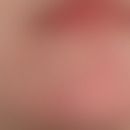DefinitionThis section has been translated automatically.
The efflorescence theory is the historically coined catalog of terms, the alphabet that must be learned to describe and communicate a disease of the skin. The basic terminology of the efflorescence theory (efflorescence or skin bloom) was derived by our dermatological ancestors in the 17th and 18th centuries from the already existing system of botany. Prominent representatives of these generations are Thomas Sydenham (1624-1698) from England, his London compatriot Robert Willan (1757-1812) and his student Thomas Bateman (1778-1821) as well as later the members of the Paris School around Baron Jean Louis Alibert (1766-1831) and those of the Vienna School around Ferdinand v. Hebra (1816-1880) and his son-in-law Moritz Kaposi (1837-1902).
History and today
The recording of an efflorescence is purely descriptive, then as now. Efflorescence in itself says nothing about the nature of the lesion. Efflorescence description relies on seemingly simple terminology such as primary and secondary efflorescences. Primary efflorescences are defined as:
- Stain
- papule (circumscribed skin condition, <1,0cm))
- nodule (>1,0cm)
- Plaque
- vesicle and blister
- Pustule
- wheal.
Furthermore, secondary efflorescences were defined and described, which follow a primary efflorescence, such as: scaling, oozing, swelling, crusting, atrophies, scars, erosions, ulcers, rhagades, fissures, a poikilodermic (colorful multifaceted) skin condition as well as necroses.
The distinction between primary and secondary florescences was undoubtedly introduced for didactic reasons by Ferdinand v. Hebra in the century before last. This distinction makes little sense from a differential diagnostic point of view. This was already the view of Jadassohn in 1930 and Siemens in 1952. Jackson writes on this matter: "Please note, that at no time do I use the terms primary or secondary with regard to descriptive morphological terms. What is seen is there".
However, what is seen must also be recognized, processed and evaluated (diagnosed). This requires a perpetual, daily, morphological training. It is an absolute misconception that one only has to have a dermatological atlas at hand, find a suitable illustration for the clinical picture at hand and the diagnosis is ready. Such a striking way of thinking contradicts any clinical experience. Knowledge, morphological perception, experience and imagination are the prerequisites for a good dermatological diagnosis. It is necessary to recognize colors and surface structures of efflorescences as well as to evaluate their morphological variability, their consistency and their interrelation. And finally, it is necessary to work out the leading symptoms from the clinical picture and to characterize them. Only then does the actual, often arduous path to diagnosis begin.
For the diagnosis, a very simple description of the findings is sufficient, which is based on the following terms:
- Spots
- Elevations
- depressions
- Hardenings
- Overlays
1. spots (color changes of any kind); large spots are also called patches
2. elevations of the skin divided into:
- solid elevations and
- non-solid elevations (protype=blister)
Solid elevations of the skin
- Papule (circumscribed elevation of the skin < 1.ocm)
- Plaque (a two-dimensional elevation, >1.0 cm)
- wheal (transient elevation due to cutaneous edema)
- Nodule (circumscribed tissue elevation lying in skin or subcutis or protruding above skin level, >1.0 cm)
- Swelling (diffuse extensive crescent-shaped elevation of the skin due to a deep-seated increase in fluid).
Non-solid elevations filled with fluid.
- Vesicle/bubble (fluid-filled elevation).
- Pustule/blister (elevation filled with pus).
3. depressions of the skin surface:
- Scar
- Atrophy
- Erosion
- Ulcer
4. indurations (hardening, only palpable, superficial or deep, flat or nodular tissue hardening)
5. deposits (scaling, crusts, oozing).
The efflorescence group "elevations" requires further subdivision into solid and non-solid elevations. Solid elevations include: papule, plaque, wheal and nodule. Non-solid includes all vesicular or pustular efflorescences. Blisters and pustules are easy to diagnose efflorescences even for the non-dermatologist. So are solid elevations. A papule is "more than a spot"; it is always palpable.
The difference between a papule and a nodule is defined by size scale. A nodule is more voluminous and larger than a papule (> 1.0 cm). The distinction between papule and plaque is equally simple. A plaque is not thicker than a papule, but only larger in area. Here, too, > 1.0 cm is a guideline. A plaque arises from papules that have moved together and fused into a (plate-like) plateau or from a centrifugally growing papule (example: granuloma anulare) that exceeds its defined size of 1.0 cm.
The distinction between papule and urtica and between plaque and urtica seems complicated at first sight. If it does not succeed right away, the dynamics of the efflorescence must be inquired or measured. A wheal, whether large or small, exists as a single efflorescence for only about 8 to a maximum of 12 hours. By marking the efflorescence, the distinction can be made very precisely. The marked wheal, irrespective of its size, disappears in any case after 12 hours.
Subcutaneous swelling, a dynamically developing, cushion-like soft skin protrusion, is a clinically simple phenomenon, but often difficult to evaluate etiologically.
A deepening of the surface can have quite different causes. It may be due to chronic insidious tissue atrophy (skin, subcutaneous or deeper structures) without a visible defect of the surface, may result from acute or chronic trauma (traumatic tissue defect of varying degrees), neoplastic or nutritive induced tissue loss. The morphological finding "ulcer of the skin", describes an open tissue defect of varying etiology.
Colors and surface structures of efflorescences
The red, non-anemic spot as efflorescence is often equated with the term purpura. The term purpura is familiar to every physician, but this term is subject to great interpretations. On the one hand, purpura means efflorescence. On the other hand, purpura includes a pathogenetic description for a process in the skin, for bleeding into the skin. Finally, the term purpura also denotes a diagnosis, e.g. "Purpura Schönlein Henoch". A look into a "dermatological encyclopedia" shows the main keyword "purpura" 57 times (!). We meet this, over 1.5 centuries accumulated registration mania, with largest respect, although thereby the understanding for these terms with Nichtdermatologen is little promoted. The spectrum of purpura terms ranges from purpura cryoglobulinämica to purpura pigmentosa progressiva to purpura Schönlein. For the doctrine of "pattern recognition" of pattern recognition, this diagnostic dilemma is fatal. So, let us untie this Gordian knot with a bold cut by throwing off historical ballast, accepting the given (the internationally naturalized naming) and cultivating a purist naming.
At this point, we will choose a simple descriptive-clinical solution approach and thereby avoid history.
The "red spot". Basically, a red spot can only result from a focal increase in erythrocyte density in the dermis. If this is caused by simple hyperemia, the red spot is anemizable: the red color can be made to disappear completely by applying suitable pressure (glass spatula or even by the thumb). The term for an anemizable red spot is "erythema".
A non-anemizable red spot can only be caused by erythrocyte extravasations (these cannot be removed by pressure, they remain in place even under strong glass spatula pressure. The red color does not disappear). For a non-anemizable red spot, there are only two possible interpretations. Either it is a non-inflammatory (e.g. traumatic) hemorrhage into the skin or otherwise an inflammatory reaction at dermal blood vessels leading to an increased permeability of blood components (especially erythrocytes). So also in this case a focal hemorrhage into the skin is detectable.
The distinction between erythema and a hemorrhagic red spot is of great diagnostic and thus also therapeutic importance. In the case of a hemorrhagic spot, i.e., hemorrhage into the skin, specific examination steps will be necessary to clarify the phenomenon. Thus, it makes sense to distinguish between noninflammatory bleeding into the skin (e.g., traumatic) and inflammatory skin bleeding (e.g., hemorrhagic vasculitis, hemorrhagic urticaria, or hemorrhagic measles).
Notice. The color "red" is of great importance for morphological diagnosis in white skin. In brown skin it loses its significance due to the color overlay.
Of course, this statement is also valid for other skin diseases, which stand out due to their special red coloration and thus also for the morphological problem of the red spot, which is even more difficult to solve in black skin. Thus, in our color gradings we refer exclusively to the "Caucasian" white skin. Dermatological diagnostics in colored people requires a different algorithm, adapted to brown or black skin.
The colors brown and black play an important role in the differential diagnosis of pigmentary and vascular tumors, among others. Thus, a particularly subtle examination may be required to differentiate a deep black seborrheic keratosis (benign) from a nodular malignant melanoma. In case of clinically questionable determination and remaining suspicion regarding the dignity of the tumor, histological examination will be inevitable.
In this eminently important differential diagnosis, light microscopic examination helps us today to further confirm the diagnosis of "seborrheic keratosis" and thus its benignity on the basis of special surface features (e.g. pseudohorn cysts).
Other colors are:
- skin-colored
- whitish
- yellow (yellow-brown; yellow-red; yellow-green)
- brown (light brown; deep brown; brown-black)
- red (light red; deep red; dusky red; red-livid)
- blue
- black
- other (green)
The distinction of the different genuine colors of skin lesions is significant to correctly classify the location of inflammations or pigments in different diseases.
Surface structures can be distinguished:
- normal/smooth - like the surrounding skin
- smooth atrophic (parchment-like)
- bumpy
- wrinkled
- horny, calloused
- hypertrichotic (increased hair)
- hypotrichotic (reduced hair)
- crusty
- weeping
- rough
- scaly
- dry
- warty (papillomatous)
- excoriated
- forked
- Wickham`s stripe pattern.
ClassificationThis section has been translated automatically.
You might also be interested in
Note(s)This section has been translated automatically.
The distinction between primary and secondary chlorescences was introduced by Ferdinand v. Hebra in the century before last. It makes no sense and can be abandoned neither for didactic reasons nor from the point of view of a differential diagnostic evaluation of a disease. This is how Jadassohn saw it in 1930 and Siemens in 1952. Jackson writes about this: "Please note, that at no time, do I use the terms primary or secondary with regard to descriptive morphological terms. What is seen is there". In this respect, the system can be reduced to 5 morphologically very easy to grasp descriptions of findings for the purpose of finding a diagnosis and also as a proposal for simplifying the theory of efflorescence:
LiteratureThis section has been translated automatically.
- Altmeyer P (2007) Dermatological differential diagnosis. The way to clinical diagnosis. Springer Medicine Publishing House, Heidelberg
- Nast A, Griffiths CE, Hay R, Sterry W, Bolognia JL. The 2016 International League of Dermatological Societies' revised glossary for the description of cutaneous lesions. Br J Dermatol. 174:1351-1358.
Ochsendorf F et al (2017) Examination procedure and theory of efflorescence. Dermatologist 68: 229-242
Outgoing links (18)
Atrophy of the skin (overview); Bubble; Bubbles; Crust; Erosion; Excoriation; Induration; Node; Papel; Plaque; ... Show allDisclaimer
Please ask your physician for a reliable diagnosis. This website is only meant as a reference.




